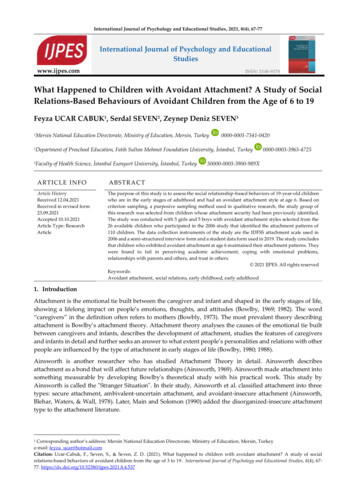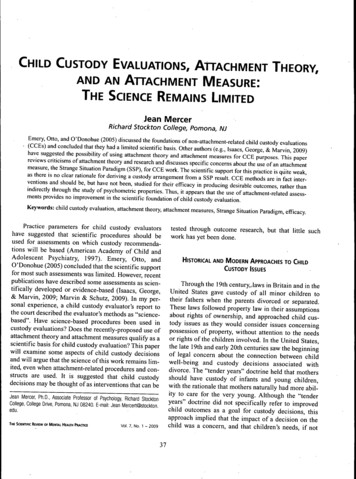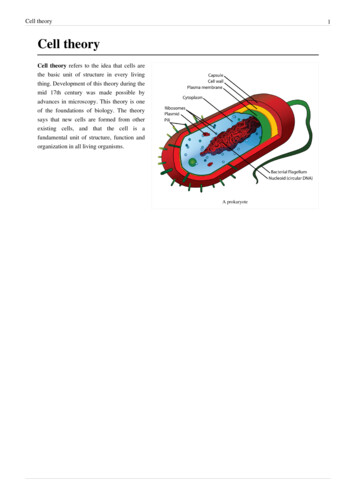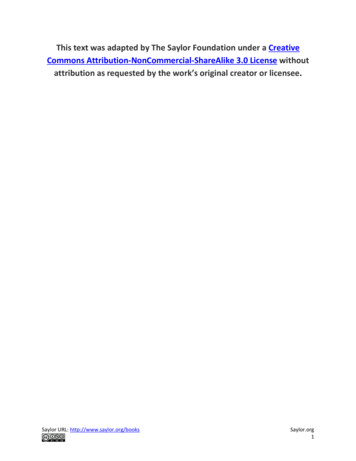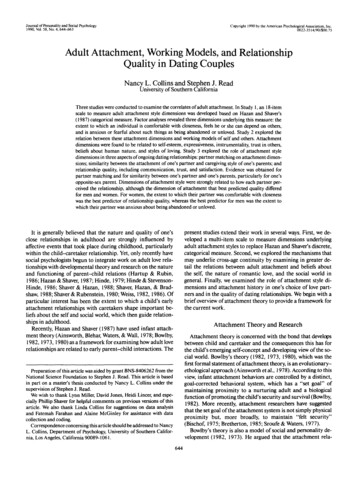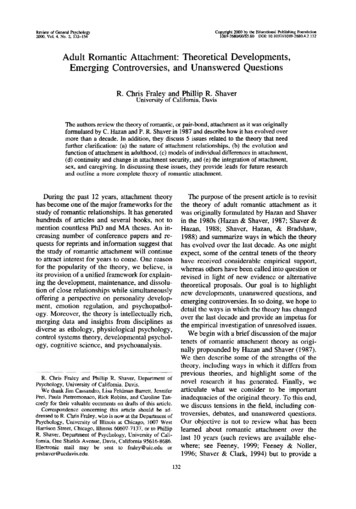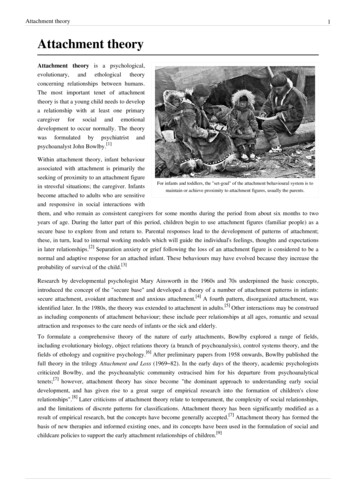
Transcription
Attachment theoryAttachment theoryAttachment theory is a psychological,evolutionary, and ethological theoryconcerning relationships between humans.The most important tenet of attachmenttheory is that a young child needs to developa relationship with at least one primarycaregiver for social and emotionaldevelopment to occur normally. The theorywas formulated by psychiatrist andpsychoanalyst John Bowlby.[1]Within attachment theory, infant behaviourassociated with attachment is primarily theseeking of proximity to an attachment figureFor infants and toddlers, the "set-goal" of the attachment behavioural system is toin stressful situations; the caregiver. Infantsmaintain or achieve proximity to attachment figures, usually the parents.become attached to adults who are sensitiveand responsive in social interactions withthem, and who remain as consistent caregivers for some months during the period from about six months to twoyears of age. During the latter part of this period, children begin to use attachment figures (familiar people) as asecure base to explore from and return to. Parental responses lead to the development of patterns of attachment;these, in turn, lead to internal working models which will guide the individual's feelings, thoughts and expectationsin later relationships.[2] Separation anxiety or grief following the loss of an attachment figure is considered to be anormal and adaptive response for an attached infant. These behaviours may have evolved because they increase theprobability of survival of the child.[3]Research by developmental psychologist Mary Ainsworth in the 1960s and 70s underpinned the basic concepts,introduced the concept of the "secure base" and developed a theory of a number of attachment patterns in infants:secure attachment, avoidant attachment and anxious attachment.[4] A fourth pattern, disorganized attachment, wasidentified later. In the 1980s, the theory was extended to attachment in adults.[5] Other interactions may be construedas including components of attachment behaviour; these include peer relationships at all ages, romantic and sexualattraction and responses to the care needs of infants or the sick and elderly.To formulate a comprehensive theory of the nature of early attachments, Bowlby explored a range of fields,including evolutionary biology, object relations theory (a branch of psychoanalysis), control systems theory, and thefields of ethology and cognitive psychology.[6] After preliminary papers from 1958 onwards, Bowlby published thefull theory in the trilogy Attachment and Loss (1969–82). In the early days of the theory, academic psychologistscriticized Bowlby, and the psychoanalytic community ostracised him for his departure from psychoanalyticaltenets;[7] however, attachment theory has since become "the dominant approach to understanding early socialdevelopment, and has given rise to a great surge of empirical research into the formation of children's closerelationships".[8] Later criticisms of attachment theory relate to temperament, the complexity of social relationships,and the limitations of discrete patterns for classifications. Attachment theory has been significantly modified as aresult of empirical research, but the concepts have become generally accepted.[7] Attachment theory has formed thebasis of new therapies and informed existing ones, and its concepts have been used in the formulation of social andchildcare policies to support the early attachment relationships of children.[9]1
Attachment theoryAttachmentWithin attachment theory, attachment means an affectional bond or tiebetween an individual and an attachment figure (usually a caregiver).Such bonds may be reciprocal between two adults, but between a childand a caregiver these bonds are based on the child's need for safety,security and protection, paramount in infancy and childhood. Thetheory proposes that children attach to carers instinctively,[10] for thepurpose of survival and, ultimately, genetic replication.[11] Thebiological aim is survival and the psychological aim is security.[8]Attachment theory is not an exhaustive description of humanrelationships, nor is it synonymous with love and affection, althoughthese may indicate that bonds exist. In child-to-adult relationships, thechild's tie is called the "attachment" and the caregiver's reciprocalequivalent is referred to as the "care-giving bond".[11]Infants form attachments to any consistent caregiver who is sensitiveand responsive in social interactions with them. The quality of thesocial engagement is more influential than the amount of time spent.The biological mother is the usual principal attachment figure, but theAlthough it is usual for the mother to be theprimary attachment figure, infants will formrole can be taken by anyone who consistently behaves in a "mothering"attachments to any caregiver who is sensitive andway over a period of time. In attachment theory, this means a set ofresponsive in social interactions with them.behaviours that involves engaging in lively social interaction with theinfant and responding readily to signals and approaches.[12] Nothing inthe theory suggests that fathers are not equally likely to become principal attachment figures if they provide most ofthe child care and related social interaction.[13]Some infants direct attachment behaviour (proximity seeking) towards more than one attachment figure almost assoon as they start to show discrimination between caregivers; most come to do so during their second year. Thesefigures are arranged hierarchically, with the principal attachment figure at the top.[14] The set-goal of the attachmentbehavioural system is to maintain a bond with an accessible and available attachment figure.[15] "Alarm" is the termused for activation of the attachment behavioural system caused by fear of danger. "Anxiety" is the anticipation orfear of being cut off from the attachment figure. If the figure is unavailable or unresponsive, separation distressoccurs.[16] In infants, physical separation can cause anxiety and anger, followed by sadness and despair. By age threeor four, physical separation is no longer such a threat to the child's bond with the attachment figure. Threats tosecurity in older children and adults arise from prolonged absence, breakdowns in communication, emotionalunavailability or signs of rejection or abandonment.[15]2
Attachment theoryBehavioursThe attachment behavioural system serves to maintain or achievecloser proximity to the attachment figure.[17] Pre-attachmentbehaviours occur in the first six months of life. During the first phase(the first eight weeks), infants smile, babble and cry to attract theattention of caregivers. Although infants of this age learn todiscriminate between caregivers, these behaviours are directed atanyone in the vicinity. During the second phase (two to six months),the infant increasingly discriminates between familiar and unfamiliaradults, becoming more responsive towards the caregiver; following andclinging are added to the range of behaviours. Clear-cut attachmentdevelops in the third phase, between the ages of six months and twoyears. The infant's behaviour towards the caregiver becomes organisedInsecure attachment patterns can compromiseexploration and the achievement ofon a goal-directed basis to achieve the conditions that make it feel[18]self-confidence. A securely attached baby is freesecure.By the end of the first year, the infant is able to display ato concentrate on his environment.range of attachment behaviours designed to maintain proximity. Thesemanifest as protesting the caregiver's departure, greeting the caregiver'sreturn, clinging when frightened and following when able.[19] With the development of locomotion, the infant beginsto use the caregiver or caregivers as a safe base from which to explore.[18] Infant exploration is greater when thecaregiver is present because the infant's attachment system is relaxed and it is free to explore. If the caregiver isinaccessible or unresponsive, attachment behaviour is more strongly exhibited.[20] Anxiety, fear, illness and fatiguewill cause a child to increase attachment behaviours.[21] After the second year, as the child begins to see the carer asan independent person, a more complex and goal-corrected partnership is formed.[22] Children begin to notice others'goals and feelings and plan their actions accordingly. For example, whereas babies cry because of pain,two-year-olds cry to summon their caregiver, and if that does not work, cry louder, shout or follow.[8]TenetsCommon human attachment behaviours and emotions are adaptive. Human evolution has involved selection forsocial behaviours that make individual or group survival more likely. The commonly observed attachment behaviourof toddlers staying near familiar people would have had safety advantages in the environment of early adaptation,and has such advantages today. Bowlby saw the environment of early adaptation as similar to current hunter-gatherersocieties.[23] There is a survival advantage in the capacity to sense possibly dangerous conditions such asunfamiliarity, being alone or rapid approach. According to Bowlby, proximity-seeking to the attachment figure in theface of threat is the "set-goal" of the attachment behavioural system.[16]The attachment system is very robust and young humans form attachments easily, even in far less than idealcircumstances.[24] In spite of this robustness, significant separation from a familiar caregiver—or frequent changesof caregiver that prevent the development of attachment—may result in psychopathology at some point in laterlife.[24] Infants in their first months have no preference for their biological parents over strangers. Preferences forcertain people, plus behaviours which solicit their attention and care, are developed over a considerable period oftime.[24] When an infant is upset by separation from their caregiver, this indicates that the bond no longer depends onthe presence of the caregiver, but is of an enduring nature.[8]3
Attachment theoryEarly experiences with caregivers gradually giverise to a system of thoughts, memories, beliefs,expectations, emotions and behaviours about theself and others.4Bowlby's original sensitivity period of between six months and two tothree years has been modified to a less "all or nothing" approach. Thereis a sensitive period during which it is highly desirable that selectiveattachments develop, but the time frame is broader and the effect lessfixed and irreversible than first proposed. With further research,authors discussing attachment theory have come to appreciate thatsocial development is affected by later as well as earlierrelationships.[7] Early steps in attachment take place most easily if theinfant has one caregiver, or the occasional care of a small number ofother people.[24] According to Bowlby, almost from the first manychildren have more than one figure towards whom they directattachment behaviour. These figures are not treated alike; there is astrong bias for a child to direct attachment behaviour mainly towardsone particular person. Bowlby used the term "monotropy" to describethis bias.[25] Researchers and theorists have abandoned this conceptinsofar as it may be taken to mean that the relationship with the specialfigure differs qualitatively from that of other figures. Rather, currentthinking postulates definite hierarchies of relationships.[7] [26]Early experiences with caregivers gradually give rise to a system ofthoughts, memories, beliefs, expectations, emotions, and behaviours about the self and others. This system, calledthe "internal working model of social relationships", continues to develop with time and experience.[27] Internalmodels regulate, interpret and predict attachment-related behaviour in the self and the attachment figure. As theydevelop in line with environmental and developmental changes, they incorporate the capacity to reflect andcommunicate about past and future attachment relationships.[2] They enable the child to handle new types of socialinteractions; knowing, for example, that an infant should be treated differently from an older child, or thatinteractions with teachers and parents share characteristics. This internal working model continues to developthrough adulthood, helping cope with friendships, marriage and parenthood, all of which involve differentbehaviours and feelings.[27] [28] The development of attachment is a transactional process. Specific attachmentbehaviours begin with predictable, apparently innate, behaviours in infancy. They change with age in ways that aredetermined partly by experiences and partly by situational factors.[29] As attachment behaviours change with age,they do so in ways shaped by relationships. A child's behaviour when reunited with a caregiver is determined notonly by how the caregiver has treated the child before, but on the history of effects the child has had on thecaregiver.[30] [31]Changes in attachment during childhood and adolescenceAge, cognitive growth and continued social experience advance the development and complexity of the internalworking model. Attachment-related behaviours lose some characteristics typical of the infant-toddler period and takeon age-related tendencies. The preschool period involves the use of negotiation and bargaining.[32] For example,four-year-olds are not distressed by separation if they and their caregiver have already negotiated a shared plan forthe separation and reunion.[33]
Attachment theoryIdeally, these social skills become incorporated into the internalworking model to be used with other children and later with adultpeers. As children move into the school years at about six years old,most develop a goal-corrected partnership with parents, in which eachpartner is willing to compromise in order to maintain a gratifyingrelationship.[32] By middle childhood, the goal of the attachmentbehavioural system has changed from proximity to the attachmentfigure to availability. Generally, a child is content with longerseparations, provided contact—or the possibility of physicallyreuniting, if needed—is available. Attachment behaviours such asclinging and following decline and self-reliance increases.[34] Bymiddle childhood (ages 7–11), there may be a shift towards mutualco-regulation of secure-base contact in which caregiver and childnegotiate methods of maintaining communication and supervision asthe child moves towards a greater degree of independence.[32]5Peers become important in middle childhood andhave an influence distinct from that of parents.In early childhood, parental figures remain the centre of a child's social world, even if they spend substantial periodsof time in alternative care. This gradually lessens, particularly during the child's entrance into formal schooling.[34]The attachment models of young children are typically assessed in relation to particular figures, such as parents orother caregivers. There appear to be limitations in their thinking that restrict their ability to integrate relationshipexperiences into a single general model. Children usually begin to develop a single general model of attachmentrelationships during adolescence, although this may occur in middle childhood.[34]Relationships with peers have an influence on the child that is distinct from that of parent-child relationships, thoughthe latter can influence the peer relationships children form.[8] Although peers become important in middlechildhood, the evidence suggests peers do not become attachment figures, though children may direct attachmentbehaviours at peers if parental figures are unavailable. Attachments to peers tend to emerge in adolescence, althoughparents continue to be attachment figures.[34] With adolescents, the role of the parental figures is to be availablewhen needed while the adolescent makes excursions into the outside world.[35]Attachment patternsMuch of attachment theory was informed by Mary Ainsworth's innovative methodology and observational studies,particularly those undertaken in Scotland and Uganda. Ainsworth's work expanded the theory's concepts and enabledempirical testing of its tenets.[4] Using Bowlby's early formulation, she conducted observational research oninfant-parent pairs (or dyads) during the child's first year, combining extensive home visits with the study ofbehaviours in particular situations. This early research was published in 1967 in a book titled Infancy in Uganda.[4]Ainsworth identified three attachment styles, or patterns, that a child may have with attachment figures: secure,anxious-avoidant (insecure) and anxious-ambivalent or resistant (insecure). She devised a procedure known as theStrange Situation Protocol as the laboratory portion of her larger study, to assess separation and reunionbehaviour.[36] This is a standardised research tool used to assess attachment patterns in infants and toddlers. Bycreating stresses designed to activate attachment behaviour, the procedure reveals how very young children use theircaregiver as a source of security.[8] Carer and child are placed in an unfamiliar playroom while a researcher recordsspecific behaviours, observing through a one-way mirror. In eight different episodes, the child experiencesseparation from/reunion with the carer and the presence of an unfamiliar stranger.[36]Ainsworth's work in the United States attracted many scholars into the field, inspiring research and challenging thedominance of behaviourism.[37] Further research by Mary Main and colleagues at the University of California,Berkeley identified a fourth attachment pattern, called disorganized/disoriented attachment. The name reflects these
Attachment theory6children's lack of a coherent coping strategy.[38]The type of attachment developed by infants depends on the quality of care they have received.[39] Each of theattachment patterns is associated with certain characteristic patterns of behaviour, as described in the following table:[36] [38]Child and caregiver behaviour patterns before the age of 18 monthsAttachmentpatternChildCaregiverSecureUses caregiver as a secure base for exploration. Protestscaregiver's departure and seeks proximity and is comforted onreturn, returning to exploration. May be comforted by thestranger but shows clear preference for the caregiver.Responds appropriately, promptlyand consistently to needs.AvoidantLittle affective sharing in play. Little or no distress ondeparture, little or no visible response to return, ignoring orturning away with no effort to maintain contact if picked up.Treats the stranger similarly to the caregiver.Little or no response to distressedchild. Discourages crying andencourages independence.Ambivalent/Resistant Unable to use caregiver as a secure base, seeking proximityInconsistent between appropriatebefore separation occurs. Distressed on separation withand neglectful responses.ambivalence, anger, reluctance to warm to caregiver and returnto play on return. Preoccupied with caregiver's availability,seeking contact but resisting angrily when it is achieved. Noteasily calmed by stranger.DisorganizedStereotypies on return such as freezing or rocking. Lack ofcoherent attachment strategy shown by contradictory,disoriented behaviours such as approaching but with the backturned.Frightened or frighteningbehaviour, intrusiveness,withdrawal, negativity, roleconfusion, affectivecommunication errors andmaltreatment.The presence of an attachment is distinct from its quality. Infants form attachments if there is someone to interactwith, even if mistreated. Individual differences in the relationships reflect the history of care, as infants begin topredict the behaviour of caregivers through repeated interactions.[40] The focus is the organisation (pattern) ratherthan quantity of attachment behaviours. Insecure attachment patterns are non-optimal as they can compromiseexploration, self-confidence and mastery of the environment. However, insecure patterns are also adaptive, as theyare suitable responses to caregiver unresponsiveness. For example, in the avoidant pattern, minimising expressionsof attachment even in conditions of mild threat may forestall alienating caregivers who are already rejecting, thusleaving open the possibility of responsiveness should a more serious threat arise.[40]Around 65% of children in the general population may be classified as having a secure pattern of attachment, withthe remaining 35% being divided between the insecure classifications.[41] Recent research has sought to ascertain theextent to which a parent's attachment classification is predictive of their children's classification. Parents' perceptionsof their own childhood attachments were found to predict their children's classifications 75% of the time.[42] [43] [44]Over the short term, the stability of attachment classifications is high, but becomes less so over the long term.[8] Itappears that stability of classification is linked to stability in caregiving conditions. Social stressors or negative lifeevents—such as illness, death, abuse or divorce—are associated with instability of attachment patterns from infancyto early adulthood, particularly from secure to insecure.[45] Conversely, these difficulties sometimes reflect particularupheavals in people's lives, which may change. Sometimes, parents' responses change as the child develops,changing classification from insecure to secure. Fundamental changes can and do take place after the critical earlyperiod.[46] Physically abused and neglected children are less likely to develop secure attachments, and their insecureclassifications tend to persist through the pre-school years. Neglect alone is associated with insecure attachmentorganisations, and rates of disorganized attachment are markedly elevated in maltreated infants.[39]
Attachment theoryThis situation is complicated by difficulties in assessing attachment classification in older age groups. The StrangeSituation procedure is for ages 12 to 18 months only;[8] adapted versions exist for pre-school children.[47]Techniques have been developed to allow verbal ascertainment of the child's state of mind with respect toattachment. An example is the "stem story", in which a child is given the beginning of a story that raises attachmentissues and asked to complete it. For older children, adolescents and adults, semi-structured interviews are used inwhich the manner of relaying content may be as significant as the content itself.[8] However, there are nosubstantially validated measures of attachment for middle childhood or early adolescence (approximately 7 to 13years of age).[47]Some authors have questioned the idea that a taxonomy of categories representing a qualitative difference inattachment relationships can be developed. Examination of data from 1,139 15-month-olds showed that variation inattachment patterns was continuous rather than grouped.[48] This criticism introduces important questions forattachment typologies and the mechanisms behind apparent types. However, it has relatively little relevance forattachment theory itself, which "neither requires nor predicts discrete patterns of attachment".[49]Significance of attachment patternsThere is an extensive body of research demonstrating a significant association between attachment organisations andchildren's functioning across multiple domains.[39] Early insecure attachment does not necessarily predictdifficulties, but it is a liability for the child, particularly if similar parental behaviours continue throughoutchildhood.[46] Compared to that of securely attached children, the adjustment of insecure children in many spheres oflife is not as soundly based, putting their future relationships in jeopardy. Although the link is not fully establishedby research and there are other influences besides attachment, secure infants are more likely to become sociallycompetent than their insecure peers. Relationships formed with peers influence the acquisition of social skills,intellectual development and the formation of social identity. Classification of children's peer status (popular,neglected or rejected) has been found to predict subsequent adjustment.[8] Insecure children, particularly avoidantchildren, are especially vulnerable to family risk. Their social and behavioural problems increase or decline withdeterioration or improvement in parenting. However, an early secure attachment appears to have a lasting protectivefunction.[50] As with attachment to parental figures, subsequent experiences may alter the course of development.[8]The most concerning pattern is disorganized attachment. About 80% of maltreated infants are likely to be classifiedas disorganized, as opposed to about 12% found in non-maltreated samples. Only about 15% of maltreated infantsare likely to be classified as secure. Children with a disorganized pattern in infancy tend to show markedly disturbedpatterns of relationships. Subsequently their relationships with peers can often be characterised by a "fight or flight"pattern of alternate aggression and withdrawal. Affected maltreated children are also more likely to becomemaltreating parents. A minority of maltreated children do not, instead achieving secure attachments, goodrelationships with peers and non-abusive parenting styles.[8] The link between insecure attachment, particularly thedisorganized classification, and the emergence of childhood psychopathology is well-established, although it is anon-specific risk factor for future problems, not a pathology or a direct cause of pathology in itself.[39] In theclassroom, it appears that ambivalent children are at an elevated risk for internalising disorders, and avoidant anddisorganized children, for externalising disorders.[50]One explanation for the effects of early attachment classifications may lie in the internal working model mechanism.Internal models are not just "pictures" but refer to the feelings aroused. They enable a person to anticipate andinterpret another's behaviour and plan a response. If an infant experiences their caregiver as a source of security andsupport, they are more likely to develop a positive self-image and expect positive reactions from others. Conversely,a child from an abusive relationship with the caregiver may internalise a negative self-image and generalise negativeexpectations into other relationships. The internal working models on which attachment behaviour is based show adegree of continuity and stability. Children are likely to fall into the same categories as their primary caregiversindicating that the caregivers' internal working models affect the way they relate to their child. This effect has been7
Attachment theoryobserved to continue across three generations. Bowlby believed that the earliest models formed were the most likelyto persist because they existed in the subconscious. Such models are not, however, impervious to change givenfurther relationship experiences; a minority of children have different attachment classifications with differentcaregivers.[8]There is some evidence that gender differences in attachment patterns of adaptive significance begin to emerge inmiddle childhood. Insecure attachment and early psychosocial stress indicate the presence of environmental risk (forexample poverty, mental illness, instability, minority status, violence). This can tend to favour the development ofstrategies for earlier reproduction. However, different patterns have different adaptive values for males and females.Insecure males tend to adopt avoidant strategies, whereas insecure females tend to adopt anxious/ambivalentstrategies, unless they are in a very high risk environment. Adrenarche is proposed as the endocrine mechanismunderlying the reorganisation of insecure attachment in middle childhood.[45]Attachment in adultsAttachment theory was extended to adult romantic relationships in the late 1980s by Cindy Hazan and PhillipShaver. Four styles of attachment have been identified in adults: secure, anxious-preoccupied, dismissive-avoidantand fearful-avoidant. These roughly correspond to infant classifications: secure, insecure-ambivalent,insecure-avoidant and disorganized/disoriented.Securely attached adults tend to have positive views of themselves, their partners and their relationships. They feelcomfortable with intimacy and independence, balancing the two. Anxious-preoccupied adults seek high levels ofintimacy, approval and responsiveness from partners, becoming overly dependent. They tend to be less trusting, haveless positive views about themselves and their partners, and may exhibit high levels of emotional expressiveness,worry and impulsiveness in their relationships. Dismissive-avoidant adults desire a high level of independence, oftenappearing to avoid attachment altogether. They view themselves as self-sufficient, invulnerable to attachmentfeelings and not needing close relationships. They tend to suppress their feelings, dealing with rejection bydistancing themselves from partners of whom they often have a poor opinion. Fearful-avoidant adults have mixedfeelings about close relationships, both desiring and feeling uncomfortable with emotional closeness. They tend tomistrust their partners and view themselves as unworthy. Like dismissive-avoidant adults, fearful-avoidant adultstend to seek less intimacy, suppressing their feelings.[5] [51] [52] [53]Two main aspects of adult attachment have been studied. Theorganisation and stability of the mental working models that underliethe attachment styles is explored by social psychologists interested inromantic attachment.[54] [55] Developmental psychologists interested inthe individual's state of mind with respect to attachment generallyexplore how attachment functions in relationship dynamics andimpacts relationship outcomes. The organisation of mental workingmodels is more stable while the individu
Insecure attachment patterns can compromise exploration and the achievement of self-confidence. A securely attached baby is free to concentrate on his environment. The attachment behavioural system serves to maintain or achieve closer proximity to the attachment figure.[17] Pre-attachment behaviours occur in the first six months of life.
